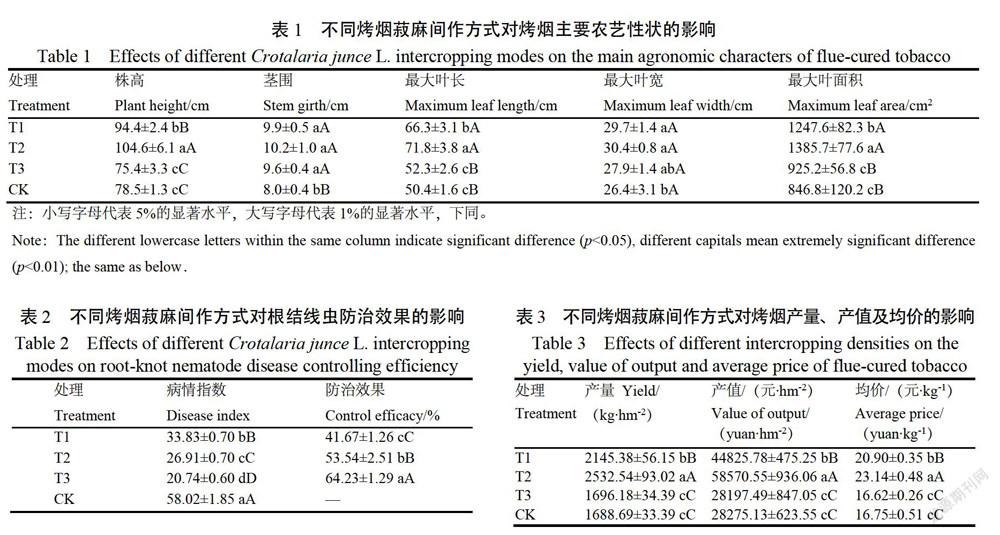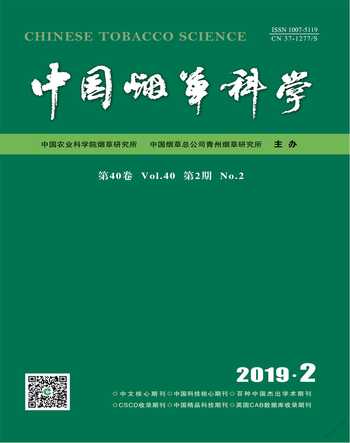烤烟菽麻间作对烟草根结线虫防效及烟叶产质量的影响
张宗锦 闫芳芳 孔垂旭 张映杰


摘 要:为分析烤烟菽麻间作对烟草根结线虫的防治效果,以烤烟品种云烟87和菽麻品种I48为材料,通过田间试验研究了3种烤烟菽麻间作方式对烤烟根结线虫防效,烤烟农艺性状、产量及产值的影响。结果表明,与烤烟单作处理相比,烤烟与菽麻间作方式为2∶1时,根结线虫的防效为41.67%,能改善烤烟的农艺性状,烟叶产量、产值和均价分别提高了456.69 kg/hm2、16 550.65元/hm2和4.15元/kg;烤烟与菽麻间作方式为1∶1时,根结线虫的防效为53.53%,并显著改善烤烟的农艺性状,烟叶产量、产值和均价分别增加了843.85 kg/hm2、30 295.42元/hm2和6.39元/kg;烤烟与菽麻间作方式为2∶3时,根结线虫防效为64.23%,降低了烤烟的株高,对烟叶产量产值等无明显提高。因此,烤烟与菽麻间作对根结线虫病具有良好的防治效果,并且能够显著提高烟叶产量、产值,以1∶1间作方式为最佳。
关键词:根结线虫;烟草;菽麻;间作方式
中图分类号:S435.72 文章编号:1007-5119(2019)02-0052-05 DOI:10.13496/j.issn.1007-5119.2019.02.008
Abstract: To analyse the effects of intercropping flue-cured tobacco with C. junce L. on controlling tobacco root-knot nematodes, a field experiment was carried out to study the effects of three different modes of intercropping tobacco with C. junce L. on root-knot nematode control efficiency, tobacco agronomic traits, yield, value of output and average price, using materials tobacco Yunyan 87 and C. junce L.I48. The results showed that, when the intercropping mode of tobacco to C. junce L. is 2 to 1, the agronomic traits of flue-cured tobacco were improved, with a nematode control efficacy of 41.67%, and the yield, value of output and average price of tobacco were increased by 456.69 kg/ha, 16 550.65 yuan/ha and 4.15 yuan/kg, respectively. When the intercropping mode of tobacco to C. junce L. is 1 to 1, the agronomic traits of flue-cured tobacco were improved significantly, with a nematode control efficacy of 53.53%, and the yield, value of output and average price of tobacco was increased by 843.85 kg/ha, 30295.42 yuan/ha and 6.39 yuan/kg, respectively. When the intercropping mode of tobacco to C. junce L. is 2 to 3, the plant height was reduced with a rate of 3.94% but no significant difference of the agronomic traits was observed compared with the no intercropping treatment. Tobacco yield was increased by 7.49 kg/ha, and the value of output and average price were reduced by 77.64 yuan/ha and 0.13 yuan/kg, respectively. These results indicated that 1 to 1 is the appropriate intercropping mode of tobacco to C. junce L. in controlling the damage caused by tobacco root-knot nematodes.
根結线虫作为烟草主要的病原线虫,近几年来在四川烟区有进一步发展蔓延的趋势,在凉山、攀枝花等烟区已成为危害烟草的主要病害之一,局部发病率超过70%,年烟叶损失率高达10%~20%,严重影响了烤烟的可持续发展[1-3]。目前有效防治烟草根结线虫病的措施仍以化学防治为主,但大多化学杀线虫剂均具有毒性大、长期使用会造成环境污染等弊端,因此大批化学杀线虫剂已被陆续禁用[4-5],促使人们开始探索更为安全有效的防控措施[6]。
相关研究证实,将抗线虫植物与易感病植物进行合理轮作或间作能有效防控根结线虫病害[7-10],抗线虫植物中以豆科和菊科植物的应用最为广泛[11-12]。国外学者曾利用轮作猪屎豆的方法成功减少了根结线虫的种群数量[13-14]。MARBAN等[15]在温室中将刀豆与番茄进行了间作,调查发现间作刀豆能显著减轻由南方根结线虫引起的植株损伤和根结数量。张瑞平等[16]将猪屎豆、孔雀草分别与烤烟进行间作来防治烟草根结线虫病,烤烟采收期平均防效分别达36.3%、43.8%。菽麻作为豆科植物的重要成员,不仅能为土壤中淡紫拟青霉的生长提供丰富的营养物质[17],且其本身也能作为根结线虫生防因子。鉴于此,本文试图对菽麻防治根结线虫的间作方式进行探索,为进一步扩大菽麻的推广应用范围和烟草根结线虫病的生物防治方法提供理论基础。
1 材料与方法
1.1 试验材料
试验于2018年5—9月在四川省攀枝花市仁和区大龙潭彝族乡干坝子村起德洪家烟田进行。试验地往年根结线虫病发生较重,地势平坦,土壤为红褐土。供试作物:烤烟品种为云烟87,菽麻品种为I48。供试烟田有机质16.97 g/kg,全氮1.13 g/kg,速效磷39.79 mg/kg,速效钾371.4 mg/kg,pH 6.34,
前茬作物为小麦。
1.2 试验设计
试验设4个处理,分别为:T1,烤烟与菽麻间作方式为2∶1(即相邻两烟株正中间作1株菽麻);T2,烤烟与菽麻间作方式1∶1(即相邻两烟株中间作2株菽麻);T3,烤烟与菽麻间作方式为2∶3(即相邻两烟株中间作3株菽麻);CK,烤烟单作。采用完全随机区组排列,3次重复。每小区植烟90株,行距1.2 m,株距0.5 m,共12个小区。间作模式如图1所示。
5月12日移栽烤烟,同日播种菽麻种子,播种深度约3.0 cm左右。整个生育期不施用任何防治烟草根结线虫病的化学及生物农药,其他栽培管理措施均按当地常规进行。
1.3 测定项目与方法
1.3.1 农艺性状 于烟株打顶时(7月13日)按照YC/T 142—2010标准在各小区中定株测量10棵烟株的株高、茎围、最大叶长、最大叶宽。
1.3.2 病情指数 于烟叶采收结束(9月12日)在各小区挖取10株烟株,按照国家标准GB/T 23222—2008记载各处理烟株根部烟草根结线虫病的发病情况,计算各处理小区的病情指数及防效。
1.3.3 產质量 以小区为单位,统计各小区的产量、产值。
1.4 统计分析
使用DPS 7.0软件进行显著性检验,Duncan氏新复极差法进行多重比较[18]。
2 结 果
2.1 不同处理烤烟主要农艺性状
从表1可以看出,随着烤烟菽麻间作方式中菽麻种植密度的增加,烤烟农艺性状的促生效果呈现出先升高后降低的趋势,烤烟农艺性状促生效果综合表现以T2处理最好,其次为T1处理,T3处理最差。T2处理在株高、最大叶长、最大叶面积方面的促生效果最明显,分别较CK提高了33.25%、42.46%、63.64%,但对茎围、最大叶宽的影响与T1处理差异不显著,T3处理的烤烟株高、最大叶长、最大叶宽、最大叶面积与CK间差异不显著。
2.2 不同处理烟草根结线虫病防效
表2数据显示,随着烤烟菽麻间作方式中菽麻种植密度的增加,烟草根结线虫病情指数呈现逐渐降低的趋势,处理T1、T2和T3的病情指数分别为33.83、26.91和20.74,根结线虫防治效果的变化趋势与病情指数相反,处理T1、T2和T3的防治效果分别为41.67%、53.54%和64.23%。
2.3 不同处理烤烟产量产值比较
如表3所示,烤烟与菽麻间作方式为1∶1(T2处理)时,产量、产值和均价均明显优于其他处理,较CK的产量、产值和均价分别增加了843.85 kg/hm2、30 295.42元/hm2和6.39元/kg。T1处理较CK的产量、产值和均价分别增加了456.69 kg/hm2、16 550.65元/hm2和4.15元/kg。T3处理较CK的产量仅增加了7.49 kg/hm2,而产值、均价较CK减少了77.64元/hm2和0.13元/kg。
3 讨 论
本研究发现,烤烟间作菽麻对根结线虫病具有良好的防治效果,且随着烤烟菽麻间作方式中菽麻种植密度的增加(1:1模式或2:3模式),烟草根结线虫病的防效也随之升高,这可能是因为间作体系中高密度的菽麻提高了其毒杀根结线虫的根系分泌物的含量[19-20],从而提高了菽麻阻碍根结线虫生长与繁殖的效率。烤烟间作菽麻可在一定范围内显著提高烤烟的综合农艺性状,增加烤烟的产量、产值及均价,这与张瑞平等[16]的研究结果一致。当烤烟与菽麻的间作方式为2∶1、1∶1时,烤烟的综合农艺性状、产量、产值和均价得到了显著提升,这是因为菽麻可作为绿肥,通过培肥改土作用[21-23]为烤烟生长发育提供了一定的养分。本研究中还发现烤烟与菽麻的间作方式为2∶3时,平均株高较烤烟单作降低了3.1 cm,产值及均价较对照组分别减少了77.64元/hm2和0.13元/kg,这可能是因为大田前期菽麻生长相对较快,菽麻在争夺水分、养分、光照等方面强于烤烟的缘故。间作生产模式中,常常无法避免的就是间作植物与目标作物之间在养分、水分、空间等方面的竞争性问题[24-25],但KNÖRZER等[26]认为只有通过间作方式配比来协调间作植物与目标作物之间在竞争性和促进性上的相互作用,使目标作物达到增产的间作方式才是最佳的间作模式,因此可否考虑在能有效控制根结线虫病的前提下,适当将烤烟早于菽麻移栽或对菽麻打顶控旺来进行改善,需要进一步研究。
4 结 论
研究表明,随着烤烟菽麻间作种植方式中菽麻密度的增加,烟草根结线虫病的防效效果增加,但间作方式中菽麻种植密度太高会影响烤烟的生长及产量、产值及均价。烤烟与菽麻间作方式为1∶1时,根结线虫的防效高达53.53%,烤烟的产量、产值和均价分别增加了843.85 kg/hm2、30 295.42元/hm2和6.39元/kg,因此烤烟与菽麻间作方式为1∶1是兼顾防治烟草根结线虫和提高烟叶产质量的有效方式。
参考文献
[1]李星月,余辉,朱从桦,等. 四川烟草根结线虫危害及其综合防控对策[J]. 四川农业科技,2018(2):31-32.LI X Y, YU H, ZHU C H, et al. The harm of tobacco root- knot nematode and its comprehensive control measures in Sichuan Province[J]. Science and technology of Sichuan agriculture, 2018(2): 31-32.
[2]张瑞平,闫芳芳,刘旭,等. 攀枝花市烤烟根结线虫病的发生与防治[J]. 四川农业科技,2015(11):44-45.ZHANG R P, YAN F F, LIU X, et al. Occurrence and control of tobacco root knot nematode disease in Panzhihua[J]. Science and Technology of Sichuan Agriculture, 2015 (11): 44-45.
[3]闫芳芳,杨军伟,杨建春,等. 攀枝花市烤烟主要病虫害发生现状与防控对策[J]. 四川农业科技,2015(7):41-42.YAN F F, YANG J W, YANG J C, et al. Present situation and control countermeasures of main tobacco diseases and insect pests in Panzhihua[J]. Science and Technology of Sichuan Agriculture, 2015(7): 41-42.
[4]金娜,刘倩,简恒. 植物寄生线虫生物防治研究新进展[J]. 中国生物防治学报,2015,31(5):789-800.JIN N, LIU Q, JIAN H. Advances on biological control of plant-parasitic nematodes[J]. Chinese Journal of Biological Control, 2015, 31(5):789-800.
[5]闫芳芳,曾庆宾,官宇,等. 猪屎豆与淡紫拟青霉联合防治烟草根结线虫病的效果评价[J]. 中国农学通报,2018,34(9):136-140.YAN F F, ZENG Q B, GUAN Y, et al. Integrated control of tobacco root-knot nematode disease by crotalaria pallida and paecilomyces lilacinus[J]. Chinese Agricultural Science Bulletin, 2018, 34(9): 136-140.
[6]陈德鑫,许家来,曹君正,等. 卵寄生真菌刀孢蜡蚧菌对烟草根结线虫的生物防治[J]. 中国烟草科学,2012,33(4):65-69.CHEN D X, XU J L, CAO J Z, et al. Biocontrol of tobacco root-knot nematodes by egg-parasiticfungus lecanicillium psalliotae[J]. Chinese Tobacco Science, 2012, 33(4): 65-69.
[7]李晓飞,王云民,徐成龙,等. 万寿菊对烟草根结线虫的杀线活性[J]. 安徽农业科学,2017,45(19):136-137,142.LI X F, WANG Y M, XU C L, et al. Nematicidal activity of marigold against tobacco root- knot nematode[J]. Journal of Anhui Agri. Sci., 2017, 45(19): 136-137, 142.
[8]贺红武,黄刚良. 作为生物合理农药资源的熱带植物[J]. 世界农药,2000,22(5):8-13.HE H W, HUANG G L. Tropical plants as biological reasonable pesticide resources [J]. World Pesticide, 2000, 22(5): 8-13.
[9]吴钜文,陈建峰. 植物源农药及其安全性[J]. 植物保护,2002,28(4):39-41.WU J W, CHEN J F. Botanical pesticides and their safety [J]. Plant Protection, 2002, 28(4): 39-41.
[10]邓志勇,邓业成,阳振. 我国植物源农药的研究与应用[J]. 南方农业学报,2006,37(6):678-681.DENG Z Y, DENG Y C, YANG Z. Research and application of plant-derived pesticides in China[J]. Gguangxi Agricultural Sciences, 2006, 37(6): 678-681.
[11]王佳,曾广智,汪哲,等. 杀线虫植物以及植物源杀线虫活性化合物研究与应用进展[J]. 中国生物防治学报,2018,34(3):469-479.WANG J, ZENG G Z, WANG Z, et al. Research and application on namaticidal plants and phytochemicals[J]. Chinese Journal of Biological Control, 2018, 34(3): 469-479.
[12]GOMMERS F J, BAKKER J. Physiological diseases induced by plant responses or products[M]//POINAR G O Jr., JANSSON H B. Diseases of nematodes, Boca Raton:CRC Press, Inc, 1988: 3-22.
[13]JAVED N, GOWEN S R, ELHASSAN S A, et al. Efficacy of neem (Azadirachta indica) formulations on biology of root-knot nematodes (Meloidogyne javanica) on tomato[J]. Crop Protection , 2008, 27(1): 36-43.
[14]姬妍茹,楊庆丽,董艳,等. 豆科植物杀线虫活性的研究应用进展[J]. 安徽农业科学,2014,42(26):8884-8886.JI Y R, YANG Q L, DONG Y, et al. Research and application on nematicidal activity of the leguminosae plants[J]. Journal of Anhui Agriculture Sciences, 2014, 42(26): 8884-8886.
[15]MARBAN M N, DICKLOW M B. Evalauation of meloidogyme and nacobueaberrans on tomato by two plant[J]. Ravde de Nematologic, 1998, 12(4): 409-412.
[16]张瑞平,曾庆宾,余伟,等. 烟草根结线虫病不同防控措施的田间筛选[J]. 中国烟草科学,2016,37(4):54-59.ZHANG R P, ZENG Q B, YU W, et al. Different measures of controlling tobacco root-knot nematode disease in the field [J]. Chinese Tobacco Science, 2016, 37(4): 54-59.
[17]赵琼玲,白昌军,虞道耿. 猪屎豆属植物的利用价值及开发前景[J]. 热带农业科学,2008,4(4):71-74.ZHAO Q L, BAI C J, YU D G. Prospects for development and utilization of crotalaria[J]. Chinese Hinese Journal of Tropical Agriculture, 2008, 4(4): 71-74.
[18]宋辉,亚平,杨明文,等. 烟草根结线虫病防治药剂的田间筛选研究[J]. 云南农业大学学报,2011,26(6):740-748.SONG H, YA P, YANG M W, et al. Study on pesticide control of tobacco root- knot nematodes disease in field [J]. Journal of Yunnan Agricultural University, 2011, 26(6): 740-748.
[19]DANAHAP L S, WONANG D L. Antinematicidal efficacy of root exudates of some crotalaria species on meloidogyne incognita (root-knot nematode) (kofoid and white) chitwood isolated from infected Lycopersicum esculentum L.(tomato) plant[J]. International Journal of Scientific & Technology Research, 2016, 5(3): 70-84.
[20]MARIA S R, MOSJIDIS R N H. Evaluation of crotalaria juncea populations as hosts and antagonistic crops to manage meloidogyne incognita and rotylenchulueniformis[J]. Nematropica, 2008, 38(2): 155-161.
[21]KOGRAM C, SIMUNGKHUN B, POOSRI B. Effects of management method and age of sunnhemp (Crotalaria juncea L.) on soil properties, growth and seed yield of roselle[J]. Thai Journal of Soils & Fertilizers, 2005, 23(2): 39-53.
[22]SHARMA S, DEV S P, RAMESHWAR. Effect of green manuring of sunnhemp (Crotalaria juncea L.) on rice yield, nitrogen turnover and soil properties[J]. Crop Research, 2000: 418-423.
[23]EDJE O T, MABUZA H. Effects of using sunnhemp [Crotalaria juncea L.] as a green manure crop and as an intercrop with maize [Zea mays L.] in Middleveld of Swaziland. I: Maize morphological responses and potential fodder value of biomass[J]. African Journal of Applied Agricultural Sciences and Technologies, 2014,1(1): 19-27.
[24]TSUBO M, WALKER S, MUKHALA E. Comparisons of radiation use efficiency of mono-inter-cropping systems with different row orientations[J]. Field Crops Research, 2001, 71(1): 17-29.
[25]KEATING B A, CARBERRY P S. Resource capture and use in intercropping: solar radiation[J]. Field Crops Research, 1993, 34(3-4): 273-301.
[26]KNÖRZER H, GRAEFF-HÖNNINGER S, GUO B, et al. The rediscovery of intercropping in China: a traditional cropping system for future Chinese agriculture–a review [M]//Climate change, intercropping, pest control and beneficial microorganisms. Netherlands: Springer, 2009: 13-44.

